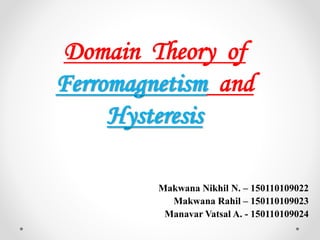Theory of Losses
- 1. Domain Theory of Ferromagnetism and Hysteresis Makwana Nikhil N. â 150110109022 Makwana Rahil â 150110109023 Manavar Vatsal A. - 150110109024
- 2. Contains ïBasic details of Domain ïEffect of External Magnetic Field on the Domains ïStep by step magnetization ïDetails about Hysteresis ïExplanation of Hysteresis on the Basis of Domain Theory
- 3. Terminologies ï FERROMAGNETISM: âFerromagnetism is a phenomenon in which a material gets magnetized to a very large extent in the presence of an external field.â ï DOMAIN: âA specimen of ferromagnetic material consists of different region which are spontaneously magnetized below the Curie temperature. These spontaneously magnetized or self magnetized regions in a ferromagnetic material is called the domains.â ï HYSTERESIS: âHysteresis is lagging (phase lagging) of magnetic induction B in ferromagnetic and ferrimagnetic materials with respect to the cyclic variation of an applied magnetic field, when the specimen is at a temperature below its Curie temperature.â
- 4. DOMAINS ï At the lower temperature than Curie, & in the absence of an external magnetic field, the direction of magnetization of each domain have random orientation in space as shown in figure.
- 5. Effect of external magnetic field on Domain ï As we know that when there is no any external field applied to the material, all the domain of the ferromagnetic material are in random direction itself.
- 6. ContinuedâĶ ïBut when the external magnetic field is applied to any ferromagnetic material, its domain tends to get aligned in the direction of the external field.
- 7. ContinuedâĶ ï As the external magnetic field becomes stronger, all the domains gets completely aligned in the direction of the external magnetic field.
- 8. Hysteresis ïAs we have earlier seen that the âHysteresis is lagging (phase lagging) of magnetic induction B in ferromagnetic and ferrimagnetic materials with respect to the cyclic variation of an applied magnetic field, when the specimen is at a temperature below its Curie temperature.â ïIt is the graph of Magnetic flux density (B) versus magnetic field (H). ïIt is also known as hysteresis curve.
- 10. Explanation ï As we increase magnetic field H, value of B also increases and the curve develops along Oa. At a, if H is further increases, B remains constant. If H is done 0, then value of Ob at point b is called the RETENTIVITY. ï Now when the value of H is increased In the reverse direction, B becomes 0 at C point and specimen gets completely demagnetized. This value of H i.e. OC is called the coercive field Hc. This effect is called COERCIVITY. ï If H is further increased in reverse direction, B also increase in reverse direction and follows the path de instead of dc. ï Now, if H in increased in the main direction, specimen gets completely demagnetized at f. Thus variation B with respect to H traced along the closed path abcdefa in one full cycle of magnetization and demagnetization is called the hysteresis curve. ï The area enclosed by the curve gives the energy loss per unit volume of the material per cycle.
- 11. Hysteresis on the basis of Domain
- 12. Thank youâĶ











